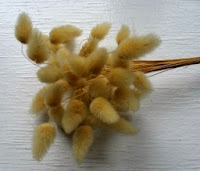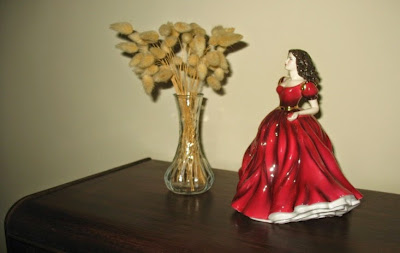Their names, bunny tails
and immortals, bring to mind story book fantasies. We have yet again two plants that grew in the
same places.
I used to see bunny tails in small vases placed on end tables in family friends’ and relatives’ homes in the 50s. I have a memory of loving it at first site in a great uncle’s home in the city of Tire in western Turkey. On the end tables it decorated, there would also be porcelain figurines beside the vase of bunny tails.
Lagurus ovatus by its scientific name and hare’s tail or bunny tails as it is commonly known, this plant is the sole species in the monotypic genus Lagurus. Monotypic indicates having one representative. The genus Lagurus contains a single species named ovatus, meaning egg shaped.
Bunnytails is a member of the large Poaceae family. It is native to the Mediterranean coasts from Portugal, all of Southern European countries to Turkey, Syria, Jordan and Israel, the North African countries and the Canary Islands and the Azores. It has been introduced to Britain and thrives on sandy stretches near the sea. It blooms from late spring to early fall.
I came across my first clump of bunny tails in nature later in life. I found it in Kadınlar Denizi, 300 to 400 meters inland from the sea and about 10-15 meters above sea level, in what is typically the Mediterranean basin scrubland. Scrubland is the driest areas in the Mediterranean, especially areas near the seacoast where wind and salt spray are frequent. Low, soft-leaved scrublands are known as the garrigue in French. Such places around Kuşadası also had abundant number of olive trees. More and more of them are being cut down.
Bunny tails is a very appealing clump-forming herbaceous ornamental grass, herbaceous meaning that the stems are herb like. The green foliage can grow up to 50cm tall. The oval flower heads start out green and turn to a warm tan as they ripen all summer. Although the plant is an annual, the flower heads dry beautifully without losing their color or form and one can keep them for years.
Where I found bunny tails I also saw immortals or more correctly l’immortelle as this plant is called in French. Had I gathered some they would have lasted for ever just like the bunny tails. Unlike the bunny tails there are an estimated 600 varieties of this everlasting flower. I cannot be certain of the name of the specific immortelle that I like. From what I have learned I conclude that I’m looking for one of these three: Helichrysum stoechas, Helichrysum arenarium or Helichrysum italicum. Unless I were to take a field trip with a botanist I could not be sure which name fits. I did take one little trip to the corner l’Occitane store though (ca.loccitane.com). They fill up the store and the window with immortelle each year and I rejoice that I can see the plant again and again. This time I went in and asked permission to photograph the flowers on display. I asked but they do not sell them.


The genus name Helichrysum is derived from the Greek word helisso which means ‘to turn around’ and chrysos which means ‘gold’. Some web sites give the meaning as helios meaning ‘sun’ and chrysos meaning ‘gold’ or ‘the color of gold’, together meaning ‘sun gold.’ The genus is classified under the Asteraceae or the sun flower family. Sun flowers turn towards the sun.
Immortelle is a perennial plant with silvery green leaves and yellow flowers. Its most distinct characteristic is its delightfully inviting smoked, spicy and earthy smell that permeates throughout the scrublands under the blazing sun.
Helichrysum stoechas and Helichrysium arenarium varieties of the plant grow in Turkey as they do in other Mediterranean countries and all the way to the Caucasus. Stoechas flowers from April to July. Arenarium goes on to give flowers until September and even October.
Medicinal properties of the immortelle have been known since ancient times.
L’Occitane has been working with the Helichrysum italicum variety since 2001. They harvest it for its oil to be used in their products. This is a very costly oil and scarcely available, but unlike other essential oils which have a short shelf life, this oil can be stored for a very long time they tell us on their web page.
Helichrysum Italicum is native to France, Italy and a few neighboring countries. This immortelle grows on the island of Corsica, especially in the Balagne region, which includes Calvi and the Ile Rousse and their scrub-covered mountains which plunge into clear and calm waters of the Mediterranean. L’Occitane manages 44 hectares of the plant on Corsica and produces close to 200 kilograms of essential oil.
My friends from when we roamed the land where these beautiful plants grew sadly did not quite remember them years later. And the land, parceled out not too long ago has been turned into crummily paved streets and shabbily built districts of Kuşadası.





Wow!
ReplyDeleteIts amazing how you can put down memories in this way.
Such rich details of thoughts and plants inter-vined together as a masterpiece.
Thanks a lot for dropping by my blog and garden.
Have a nice weekend.
Thanks James. You too, have a nice weekend.
DeleteSo lovely. I'd have more of these in vases around the house, maybe, if the cats weren't so interested in them :-)
ReplyDelete